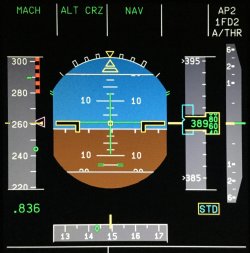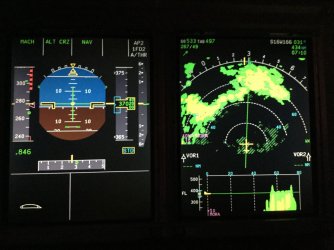In the QF72 book (the rogue A330) the capt talks about reducing cruise speed during turbulence. How common is this, and to what extent?
A large airliner in the cruise can have a quite restricted margin of available speeds. If you are cruising (an A380) at .85, you are operating .04 mach below Mmo (the max mach number), and as little as .02 above the “green dot” speed. So that’s about 20 kias below the absolute max, and about 10-15 above the green dot. Narrowing that a bit more is the speed protection that may become active about .87. So, actual margins of 10 knots in either direction, are quite common, especially just after a climb.
As the aircraft burns fuel, and becomes lighter, the green dot is continually recalculated, and slowly reduces (speed). So, the margin slowly increases. If, on the other hand, you’ve climbed early (i.e. heavy), there may be very little margin between your cruise speed and the green dot.
The upshot of this is that there is very little potential to reduce speed, and it literally falls into the category of trivia. Airbus do mention it in discussion of turbulence, but what they actually say is that you could consider reducing speed in SEVERE turbulence. You don’t have to, and there is very limited benefit. The structure is in no danger either way, but it may make the ride marginally less bumpy. If you want a car analogy, it would be the same as driving down a very rough road at 100 kph versus 97 kph.
There is a very real negative to slowing down though. The green dot speed is treated by most pilots as the minimum speed that they should be flying at. It actually isn’t though, it’s the speed with the best lift/drag ratio. The actual minimum, when the angle of attack (i.e. stalling) becomes a consideration, is about 30-50 knots slower. So, if I slow towards green dot, the drag is decreasing, and I’ll need less power. But, go below the dot, and drag will start to rise again, and more power will be needed to get back to the dot. Slow down enough, and the drag will overwhelm the power, and not only will you be unable to maintain the speed, but the speed decay will continue. The only fix at that point is to descend, trading off height for speed. In the cruise, the point at which you won’t be able to accelerate is only about 10 knots slower than the dot.
The narrowing of the speed margins with increasing height is one of the reasons that you never attempt to outclimb weather. In fact, it may be sensible to do the opposite. A descent of 4,000’ may put you more deeply into any weather, but it will substantially increase the margins. I don’t recall that being mentioned in the AB manuals, but it was covered in Boeings.
The images show the displays at a couple of different altitudes. Speed is on the left of the attitude indication.






















